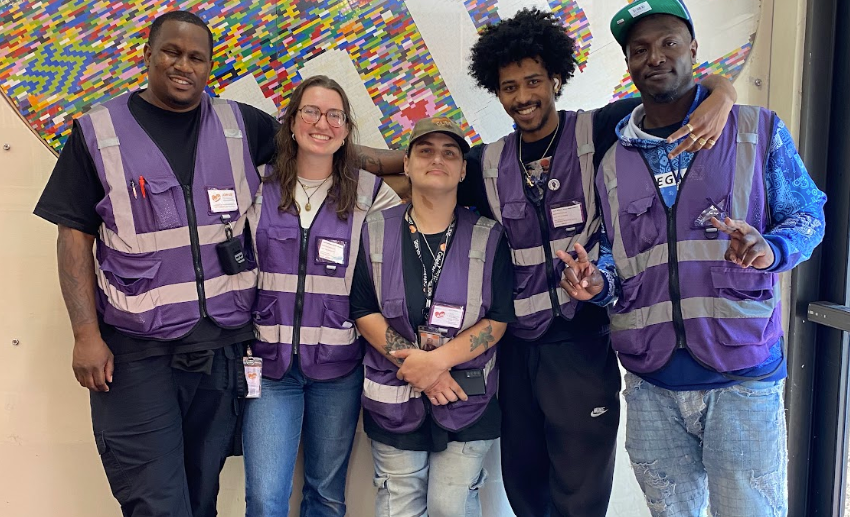
The day begins at 7:30 am. As San Francisco wakes up, GLIDE’s Community Ambassadors are already on the streets.
Every morning and afternoon, the 12 Ambassadors walk 30 blocks of the Tenderloin — picking up trash, greeting the neighbors, performing wellness checks on the neighborhood’s many unhoused residents, and connecting people to supportive services where needed.
I volunteered to do a walk-along with the Community Ambassadors for a day, which anyone is welcome to do by signing up in GLIDE’s volunteer portal. As a new intern at GLIDE, I wanted to walk with the Ambassadors to get a better understanding of what they see on the streets.
One thing became abundantly clear very quickly: the Ambassadors are not just there to perform a perfunctory role. The job involves a lot of outreach, de-escalation, and smart communication — and occasionally, live-saving intervention.
“I distributed 3 doses of Narcan last week to people on the street,” one Ambassador tells me, referring to the over-the-counter medication that can reverse an opioid overdose on the spot. “I like knowing that I can be there to save someone’s life.”
What is the Community Ambassador Program?
The Cecil Williams Community Ambassador Program is part of GLIDE’s focus on mobile care, which brings GLIDE’s resources and services out into the community. Ambassadors are GLIDE employees, but they rarely work from the office. Instead, they spend all 8 hours of their day out in the field.
The program kicked off in July 2024 through a partnership with the Nob Hill Neighborhood Association. Residents of the Lower Nob Hill and Tenderloin neighborhoods wanted to find a more community-centric approach to caring for the many people living on the street — a solution that didn’t rely solely on police intervention and escalation.
The Ambassador program works in tandem with the many other entities working to clean up the streets in the Tenderloin: government groups like the Department of Public Works (DPW) or the Homeless Outreach Team (HOT) and other nonprofit organizations like the Tenderloin Community Benefit District (TLCBD).
The Benefit of Lived Experience
What sets the Ambassador Program apart, however, is who they hire. Most of GLIDE’s Community Ambassadors have lived experience with homelessness, drug use, addiction, or incarceration.
While many of these issues overlap, the context matters. Incarceration, drug use, and homelessness are not entirely due to one’s own personal mistakes. For example, it’s a common stereotype that substance use can lead to homelessness – however, studies have found that many homeless people turn to drugs after becoming homeless, using them as a coping mechanism for pain and safety issues experienced on the streets. The Ambassadors understand this and can respond appropriately.
“It’s easy for me to figure out how to approach someone on the street based on what high they’re on. Anyone who’s done drugs knows that you can’t talk to someone on meth the way you talk to someone who’s on heroin,” says one Ambassador. He laughs. “And it’s very different if they’re drunk.”
When I asked him if people who don’t have experience on the street know these different approaches, he shook his head. “It’s a lived skill. It’s very hard to teach.”
For one of the Ambassadors, this work is deeply personal. “I was homeless for most of my life. I came to San Francisco and lived in a tent out in China Basin,” she tells me. “A lot of my friends are still on the streets. I see them here in the Tenderloin, and I try to take care of them.”
Many of the Ambassadors also live in the Tenderloin. As we pass by different groups, Ambassadors say hi to neighbors and friends.
There’s visible camaraderie with one group in particular: a lively ensemble that hangs out on the corner of Larkin and Geary. About 10-15 people are playing music and chatting. As we walk down the block, Ambassadors shake hands, give hugs, smile, say hi to people they know, and pet the cluster of dogs running around.
It’s this part of the Tenderloin — the one filled with community, love, friendships, and vibrance — that so often goes unnoticed.
Balancing Community Needs in Both Morning and Afternoon Shifts
The Tenderloin can often feel like a place of extremes. This neighborhood has both the highest concentration of children in San Francisco and the highest number of people living on the street.
By 8 am, for some residents on the streets, the day is just beginning. Others have been up for hours. Some people have already begun using drugs, or are sleeping off last night’s high. At the same time, kids are walking to school. Working mothers are waiting at the bus stop. Local business owners are opening up shop. Balancing this dichotomy is a crucial aspect of the Ambassadors’ jobs.
The Ambassadors do two shifts: morning and afternoon. The morning shift involves picking up trash and keeping the street clean. It also involves waking people who are sleeping on the street and asking them to move if they’re in front of businesses, apartment buildings, bus stops, or busy corners.
“We’re not trying to kick anyone out of their spot or ruin anyone’s day, but kids need to be able to go to school without seeing someone passed out on their doorstep,” one Ambassador tells me.
To my surprise, many folks seemed to understand when Ambassadors asked them to move. I was expecting resistance, even anger – but most people we spoke with were quiet, apologetic, tired.
In the afternoon, the Ambassadors make the rounds again. This time, they focus on checking in with people on the street, having deeper conversations and connecting them to care.
“I see a lot of the same people every day, so I get to know what they’re dealing with,” says one Ambassador. “I started talking with a guy who really needed surgery but couldn’t get healthcare. After a few months, I finally got him connected with someone who is going to help him schedule his surgery.”
“Everyone Always Ends Up in the Tenderloin”
My walk with the Community Ambassadors through the Tenderloin was eye-opening, difficult, and heart-warming all at once. I came away with a deeper appreciation for the Tenderloin and the role that GLIDE plays in looking after the neighborhood.
One of GLIDE’s approaches is to meet people where they’re at. The Ambassadors model this through their work, showing up each day and forming relationships with each member of the Tenderloin community.
A key motivation of forming these long-lasting relationships is the knowledge that these problems are persistent — so the solutions need to be persistent too.
One Ambassador spoke to the cyclical nature of homelessness in San Francisco: “People living down in SOMA get kicked out and then go to the Mission, then they get kicked out and they go to Civic Center, then they get kicked out and they end up here,” she tells me. “It’s all one big circle, but everyone always ends up in the Tenderloin.”
How can we use more community care to end homelessness in San Francisco?
Ending homelessness in San Francisco seems like no easy feat. However, programs like the Community Ambassador Program are a step in the right direction.
At GLIDE, there’s as much focus on preventing homelessness as there is on helping the unhoused access basic needs. 317 people received rental assistance this year from GLIDE. Over 2,000 people got connected to social benefits like CalFresh and SSI. And programs like GLIDE’s Family, Youth and Childcare Center provide no-cost childcare and after-school programs for kids, allowing working parents to keep their jobs.
Community Ambassadors do something powerful that many other folks are missing: they see people. They don’t walk by the man sleeping on the street. They stop for him, check on him. They ask if he needs food, water, or a hygiene kit. They invite him to GLIDE.
